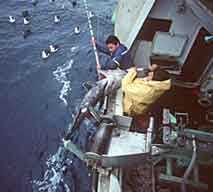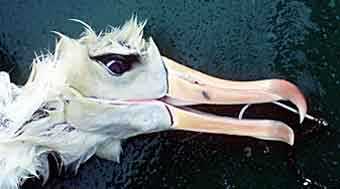|
Pelagic longline fisheries target tunas (eg. blue fin tuna, yellow fin tuna, big eye tuna, albacore tuna) and swordfishes. These species are caught from 50-300 metres deep in the water on longlines suspended by floats.
Operations vary from small boats that fish close to the coast to vessels that fish on the high seas.
Vessels that fish on the high seas might have freezers of 200-300 tonnes capacity and can stay at sea for several months.
Pelagic longliners might deploy longlines up to 130 km long with 3,000 hook-bearing branch lines. Branch lines are usually 30-40 metres in length and 50 metres apart on the longline, and are light enough to bob up and down in the water column in order to attract fish. Longlines are set and hauled back in on every day of the fishing operation.
Demersal longline fisheries are also called ground fisheries because they target fishes that live at-or-near the seabed. Species targeted include hake, ling, cod, sablefish, halibut and Patagonian toothfish.
Demersal species are often caught in very deep water – for instance the Patagonian toothfish can be caught from 500-2,500 metres deep.
Demersal longlines differ from pelagic longlines in that the branch lines (holds the hook) on demersal lines are only 0.4 m long and are spaced 1.4 m apart. This means that even reasonably short longlines might carry a very large number of hooks: demersal longline vessels might set and haul up to 40,000 hook/day.
Seabird mortality in longline fisheries
What seabirds are affected and how do they get killed?
The main species of seabirds killed in longline fisheries are albatrosses and other species of petrel.
The main mortality occurs in the southern oceans south of 30°S, and in the northern oceans north of 30°N.
In the northern hemisphere the commonest species killed are the Arctic fulmar, black-footed albatross, laysan albatross and various species of shearwater, while in the Southern Hemisphere examples of species killed include the
black-browed albatross, grey-headed
albatross, wandering albatross, shy
albatross, white-chinned petrel and
grey petrel. It should be noted, however,
that any species of seabird in the petrel
family that is aggressive and good at
seizing prey (or baited hooks) at the
waters’ surface, or is a proficient diver,
will be vulnerable to longline fishing.
|

